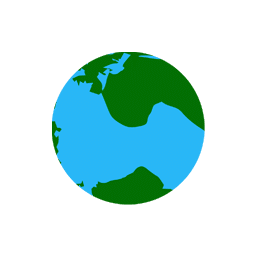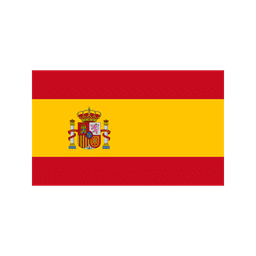
Cotton is the most important among the natural plant fibers and land for cotton cultivation covers large areas of the planet. Due to climate, the growing areas are limited to a belt of 30° south and north from the equator. The largest cotton producing areas are in the USA, China, Paraguay, Mexico, Pakistan, Australia, Brazil, the C.I.S., Turkey, Sudan, and Egypt. It is not known precisely how old cotton is. In the Indus River Valley in Pakistan, cotton was being grown, spun, and woven into cloth 3,000 years BC. At about the same time, natives of Egypt’s Nile valley were making and wearing cotton clothing. When Columbus discovered America in 1492, he found cotton growing in the Bahama Islands. By 1500, cotton was known generally throughout the world.
Cotton (Gossypium spp.) belongs to the botanical family Malvaceae. It is an erect branched shrub, up to 3 m high. The cotton plant has an indeterminate growth habit, in that its vegetative and reproductive developments occur at the same time. The leaves are spirally arranged on the stems. They are generally palmate with 3 or 5 lobes, pubescent to glabrous. The flowers are solitary, pentamerous, white to pale yellow in color, and rarely tinted with purple in the center. They are borne on 1-4 cm long pedicels and wrapped into three bracteoles that remain around the fruit after pollination. The fruit (called a “boll”) is a capsule, that splits open when mature. Each capsule contains many seeds, each seed is surrounded with downy fiber, white or creamy in color and easily spun. Cotton has a tap root system, and the roots can grow up, making them twice if the plant height.
The plants development occurs through different phenological stages: vegetative and reproductive growth stages. After sowing, seeds germinate in 5 to 10 days and the cotton plant begins its growth with two cotyledons until the plant forms true leaves. As a cotton plant begins to grow, it develops a series of nodes up the main stem. Beginning with the fifth or sixth node, the plant begins to form fruiting branches, which bear the cotton fruit. Typically, a cotton plant will continue to add nodes and fruiting branches for a total of 16 to 22 nodes, with 12 to 16 fruiting branches.
Once pollinated, the flower petals wither and a green capsule or “boll” is formed. The capsule contains a few oil glands as well as many dark brown seeds that are encased in lint and fuzz. The fibers we associate as “cotton” are a matrix of singular, epidermal cells that are attached to the seed coat. The capsule eventually dries, and splits open on four sutures to reveal the seeds and white fibers. The edge of the opened capsule hardens and turns tan, turning into sharp, thorn-like claws surrounding the fibrous core. If not harvested, weather will eventually cause the fibers to scatter in the wind, dispersing seeds for later germination.
Cotton is a perennial plant cultivated as an annual.
The most widely cultivated cotton species are:
Cotton is a semi-xerophyte plant, and it is grown in tropical & sub-tropical conditions. A minimum temperature of 15 °C is required for better germination at field conditions. The optimum temperature for vegetative growth is 21-27 °C and it can tolerate temperature to the extent of 43 °C but temperature below 21°C is detrimental to the crop. Cotton is best grown in soils with an excellent water holding capacity. Aeration and good drainage are equally important as the crop cannot withstand excessive moisture and water logging. The major soil types suitable for cotton cultivation are alluvial, clayey, and red sandy loam.
All nutrients play an important role in the metabolic activities of a plant. A nutrient higher in quantities cannot replace the role of another deficient nutrient. Plants express deficiency of a nutrient through symptoms on their leaves, stems and in their growth.
The crop also benefits from the application of products with a biostimulant action, based on beneficial microorganisms and vegetable protein hydrolysates. These products can stimulate the emergence and root development in the early stages of seedling development, to improve the availability of nutrients in the soil, to increase the yield from a quantitative and qualitative standpoint, to reduce the negative impact of climatic stresses and of herbicide treatments. The application of biostimulants increases the environmental and economic sustainability of the production system.
Nitrogen (N) is probably the most important fertilizer used on cotton, yet it is the most difficult to manage. Low N rates can reduce yield and quality while excessive N rates can cause rank growth, boll rot, delayed maturity, difficult defoliation, and poor quality and yield. Cotton demand for N is low early in the season, picks up through early fruiting, is high at peak bloom, and gradually declines as the crop approaches and proceeds through a cutout.
Phosphorus (P) is important in promoting early rooting. P can be applied in a starter fertilizer with N, which can be beneficial on heavier soils testing low in P or in cool soils. A starter fertilizer can also provide more benefit in wet and cooler conditions than in dry and hotter conditions. The uptake of P by cotton is most critical early in the growing season because P is necessary to stimulate early root development and early fruiting.
Potassium (K) is critical for boll formation. Like N, K is also required in large quantities after first bloom, and the demand for K can exceed N demand during this time. K uptake increases during early boll set, with some 70% of the total uptake occurring after first bloom. Soil application is the best way to supply K.

Before sowing


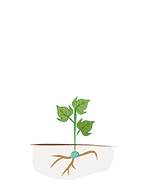
Leaf development



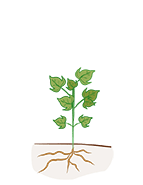
Vegetative growth



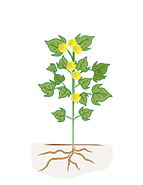
Flowering


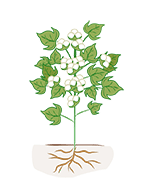
Fruit development

Agricultural soil is a fundamental component of the agricultural ecosystem. The most widely recognized function of soil is its support for food production. It is the foundation for agriculture and the medium in which nearly all food-producing plants grow. Healthy soils supply the essential nutrients, water, oxygen and root support that our food-producing plants need to grow and flourish. Soils also serve as a buffer to protect delicate plant roots from drastic fluctuations in temperature. Furthermore, the soil also performs hidden and less evident functions called ecosystem services. Careful soil management is one essential element of sustainable agriculture and provides a valuable lever for climate regulation and a pathway for safeguarding ecosystem services and biodiversity. Hello Nature propose an integrated approach to keep agricultural soil alive and healthy applying sustainable solutions: organic fertilizers, vegetal derived plant biostimulants and beneficial microbials. These solutions act on two of the main indicators of soil health, organic matter and biodiversity.
Plants need the right combination of nutrients to live, grow and reproduce. When plants suffer from malnutrition, they show symptoms of being unhealthy. Too little or too much of any one nutrient can cause problems. Plant nutrients are naturally obtained by the roots from the soil. Thus, nutrients may be physically present in the soil, but not available to plants. A knowledge of soil pH, texture, and history can be very useful for predicting what nutrients may become deficient and if leaf application of fertilizers and biostimulants may be necessary to ensure the optimal growth and development rate. Yield and the quality are strongly linked to the supply of nutrients through fertilizers product. However, nowadays sustainable fertilization management is essential to increase the overall performance of cropping systems by providing economically optimum nourishment to the crop while minimizing nutrient losses and supporting agricultural system sustainability by increasing Nutrient Use Efficiency (NUE). Plant biostimulants represent a promising strategy to boost sustainable agricultural production thanks to their capacity of improving directly or indirectly nutrient use efficiency of crops especially under low nutrient availability.
All growers, conventional and organic, have an interest in gaining back the yield potential lost due to abiotic stresses. It’s proven that on the average, farmers can harvest only 50% of the yield potential. The yield gap can be caused by biotic and abiotic stresses with a stronger negative impact of abiotic stresses. In fact, abiotic stresses like heat, cold, salt, drought and flooding caused from 65 to 75% of the yield gap, while biotic stress only 25 to 35%. Our vegetal protein hydrolysates, containing Plant Stimulating Peptides (PSP) have been shown to consistently help plants better recover from stress events also after herbicide application by increasing antioxidant supply, stimulating antioxidant biosynthesis, and activating antioxidant defense enzymes. PSPs maintained higher photosynthetic activity and a better nutritional status in the shoot tissues leading to a higher crop performance.
Cotton yields may be limited unless adequate amounts of all required nutrients are accumulated in the plant during its growth. Most soils where cotton is grown commonly have deficiencies of nutrients that requires addition of fertilizers to optimize production. Mineral nutrient deficiencies can limit the growth and yield of cotton, particularly when they occur during the reproductive phase. For this reason, cotton producers should aim to eliminate the chance of mineral nutrients becoming limiting during the flowering and fruiting period. Mainly cultivated for its natural fiber, cotton also is the second largest potential source of plant protein and the fifth largest oil-producing plant in the world. Therefore, maintaining high quality fiber and cottonseed nutritional value is critical. Application of our vegetal protein hydrolysates, containing Plant Stimulating Peptides, as foliar spray with herbicide or other pesticides is able to improve quality traits of the final product: fiber and seeds.
